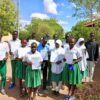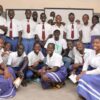
Adut Machar and Maggy Mabil are female soccer players (known as “football” in most parts of the world). They are also best friends, who meet up each morning by 6:00 a.m to go for their morning jog around the neighborhood – which is in the Kakuma refugee camp, located in northwestern Kenya. They spend about two hours working out together each morning, at least four days a week. Both Machar and Mabil are South Sudanese refugees, born in the Kakuma refugee camp, and they both love playing football.

YAAO’s Team doing awareness in support of education
Machar’s family came to Kakuma in 1991, at the time of Sudan’s second civil war. At that time, South Sudan had not yet gained independence, and was still a part of Sudan. The second civil war began in 1983 and ended in 2005. The war followed an attempt by Sudan’s military government to impose Sharia law as part of its policy to Islamicize the entire country. Sudan is a Muslim-dominated country, and over 90% of the population practices Islam. The majority of people in South Sudan are Christians. About 2 million people died during the second civil war, which ended with South Sudan’s independence in July 2011. But shortly after independence, South Sudan was torn apart by a war precipitated by political jousting for power. The war lasted from 2013 to 2020, and by 2018 over 400,000 deaths had already been recorded, and an estimated 2.3 million people have reportedly escaped to neighboring countries.
Most refugees from South Sudan live in camps in Kenya, Ethiopia, Uganda, and Sudan. Even with the civil war now over, South Sudan still suffers from communal conflicts, making it difficult for refugees from the country to return home. These conflicts largely relate to the struggle for land, livestock, and water. In July 2022, 95 people were killed due to such conflict, and 17,500 people had been displaced by August.
Daily life in Kakuma
The Kakuma refugee camp ranks among the top five largest refugee camps in the world. Over 150,000 refugees live in Kakuma, and most of them come from South Sudan and Somalia. The camp is located in a desert-like environment. The sun burns hot an average of 327 days a year, and daytime temperatures reach 38 degrees Celsius on most days. Dust storms, poisonous insects and animals, and diseases such as malaria are common issues faced by the refugees living in Kakuma. Other challenges include poverty, hunger, and lack of an adequate water supply.

There is no such thing as breakfast, lunch, or dinner here. People eat whenever there’s food.
According to George Gum, a 22-year-old musician popularly known in Kakuma as Coolkid Georginho, “There is no such thing as breakfast, lunch, or dinner here. People eat whenever there’s food.” Gum is also the founder of the Young Africans Anti-poverty Organization (YAAO), a nonprofit that is working to enhance the lives of refugees in the camp.
The majority of kids in Kakuma attend poorly funded, deeply inadequate schools. Many study in classes of over 200 students. Most children are unable to study beyond secondary school due to poverty. This was true of Machar and Mabil. Sometimes the girls find it hard to think about anything but the difficulties they face in Kakuma, and the causes of those difficulties. According to 22-year-old Machar, it all takes a toll on their mental health. So to get their minds off troubled thoughts, they play football.
One man’s vision
Starting when she was 8, Mabil noticed that whenever she played football with her brothers, she felt at ease and her thoughts were diverted away from all the problems at the refugee camp onto the sport. Since then, she has remained actively involved in football.
When Gum founded YAAO in 2021, one of his goals was to provide support and mentorship to refugee girls like Machar and Mabil who are skilled athletes. He also hoped to reduce the poverty and hunger in the camp. Gum came to Kakuma at the age of 11, and as he grew older, he realized that poverty and hunger in the camp might be reduced if people lived their lives with a vision and purpose in mind.

“There are people who have lived in the camp for over 30 years, but have no vision or dream. They only care about survival, and that is why we have so much poverty and hunger,” he said.
He started YAAO with a few young refugees who were willing to volunteer their time, skills, and resources. In the beginning, they supported four refugee women in Kakuma with free sewing machines to boost the success of their fashion design businesses. After that, they purchased car wash equipment for six young refugees who wanted to become car wash attendants. The organization soon expanded into advocacy intended to reduce substance use disorders, early pregnancies, and the spread of sexually transmitted diseases in the camp. With the collaboration of health trainers, YAAO now organizes health trainings at least once every two months for teenagers in the camp. The training sessions usually have over 50 teenagers in attendance, and provide an opportunity for participants to ask questions and get answers.
Story written by Violet IKong and published by Amjambo Africa



